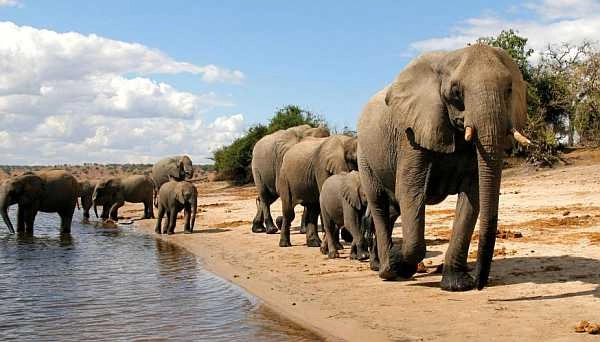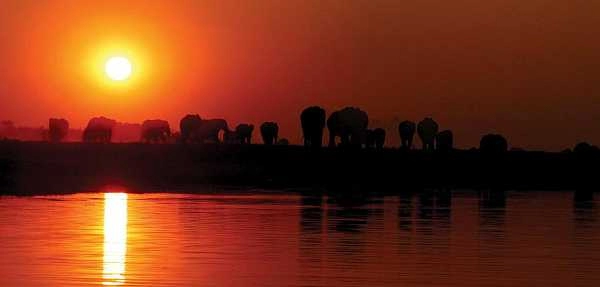Chobe National Park in northern Botswana is one of the best safari destinations in Southern Africa, due to it's number of elephants and large predator populations.

Chobe is easily accessed from the Victoria Falls area (Zimbabwe or Livingstone) - a mere 90 minute drive so it makes it the perfect safari add-on for those with limited time. Chobe National Park is the second largest national park in Botswana and covers 10,566km².
A major feature of Chobe National Park is its elephant population. Botswana's elephant population is currently estimated at around 120,000. The Chobe elephant are migratory, making seasonal movements of up to 200 kilometers from the Chobe and Linyanti rivers, where they concentrate in the dry season, to the pans in the southeast of the park, to which they disperse in the rains.
The park is divided into four distinctly different eco systems: Serondela, Savuti Marsh, Linyanti Swamps and the Dry Hinterland.
Serondela with its lush plains and dense teak forests is situated in the extreme north-east of the Chobe National Park. The Chobe River is a prime drinking spot for the elephants and buffalo. Serondela is the most visited section of the park due to it's close proximity to Victoria Falls. The main access point from Victoria Falls is Kasane, the most important town of the region.
Savuti Marsh in the western stretch of the park is about fifty kilometres north of Mababe gate. It is often described as one of, if not the best, wildlife-viewing areas in Africa today. Animals are present during all seasons, and at certain times of the year their numbers can be staggering. The Savuti Marsh area of Chobe National Park is reputed for its annual migration of zebras and predators, particularly its resident lions and spotted hyena populations. Sometimes you will have them uncomfortably close, as both they and marauding hyenas do wander through the camps. Almost certainly you will hear lion at night.
Linyanti Swamps in the north-west is in the furthest corner of Chobe National Park (to the north of Savuti) and is secluded and uncrowded. It is reminiscent of the Okavango's permanent waterways with papyrus-lined lagoons, reed-beds and a towering canopy of trees. The Linyanti Swamp covers an area of almost 900km2, to which follows the river and fills the area between the converging courses of the Kwando and Linyanti rivers. The national park only touches the river for a short section on the far eastern edge of the swamp.
The wildlife is plentiful, especially in the dry winter months when great concentrations of elephant, buffalo and zebra congregate along the river, with giraffe, impala and roan antelope being seen in the forests. The bird life is diverse, if not overwhelming in its numbers. Waterbirds, including pelican, are common.
Game viewing is at its best during the dry season, when the majority of natural pans have dried up, and it is wise to avoid the Chobe River front during the heavy rains from January to March. It is also wise to note that no fuel supplies are available within the park and visitors traveling between Kasane and Maun should ensure that they are self-contained for the entire journey. All drinking water should be boiled or chemically treated. Mosquitoes are prevalent throughout the park and visitors are strongly advised to take an anti-malarial prophylactic before, during and for four weeks from visiting the park, especially during the rainy season.
Dry Hinterland (central pans) lies between Linyanti and Savuti Marshes. It is hot and dry and little known.

To book your This email address is being protected from spambots. You need JavaScript enabled to view it., contact us now or view our Botswana Suggested Itineraries, Botswana Safari Specials or Botswana Honeymoons.
